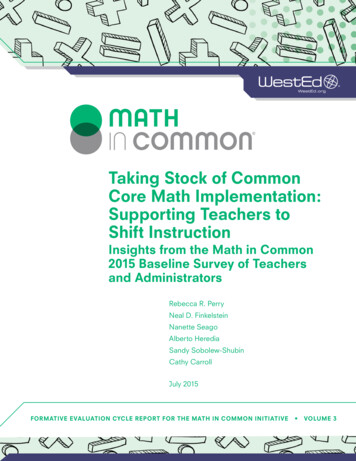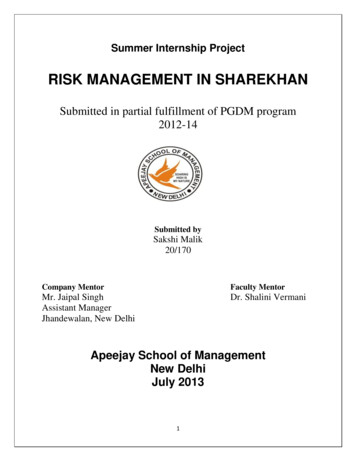
Transcription
Taking Stock of CommonCore Math Implementation:Supporting Teachers toShift InstructionInsights from the Math in Common2015 Baseline Survey of Teachersand AdministratorsRebecca R. PerryNeal D. FinkelsteinNanette SeagoAlberto HerediaSandy Sobolew-ShubinCathy CarrollJuly 2015FORMATIVE EVALUATION CYCLE REPORT FOR THE MATH IN COMMON INITIATIVE VOLUME 3
2015 WestEd. All rights reserved.Suggested citation: Perry, R. R., Finkelstein, N. D., Seago, N., Heredia, A.,Sobolew-Shubin, S., & Carroll, C. (2015). Taking Stock of Common Core MathImplementation: Supporting Teachers to Shift Instruction: Insights from theMath in Common 2015 Baseline Survey of Teachers and Administrators.San Francisco, CA: WestEd.Requests for permission to reproduce any parts of this report should bedirected to WestEd Publications Center, 730 Harrison Street, San Francisco, CA94107-1242, 888-293-7833, fax 415-512-2024, permissions@WestEd.org, orhttp://www.WestEd.org/permissions.
Table of ContentsWestEd’s Evaluation of the Math in Common Initiative.iExecutive Summary. iiiIntroduction. 1CCSS-M Implementation Survey.1Highlights from the Survey Findings. 3Educators’ Thoughts on Mathematics and the Common Core State Standards.3Professional Development to Support CCSS-M Implementation.7Teacher Training and Support for Special Student Populations. 12Instructional Materials to Support Common Core Standards Implementation. 15Teacher Supports for Implementing the CCSS-M. 18Interpreting the Survey Data: Implications for District and School-Site Planning.20References.22Appendix A: Research Methodology and Survey Sample.26Methodology. 26Plans for Subsequent Survey Administration. 28Respondent Sample. 28Appendix B: Sample Survey Item and Sub-Items .30FIGURESFigure 1. Teacher Perceptions about the Effect of CCSS-M on Teaching and Learning . 3Figure 2. Teachers’ and Site Administrators’ Perceptions about Their Mathematics Content Knowledgefor CCSS-M. 5Figure 3. Teachers’ Confidence that Their Lessons and Units . 5Figure 4. Perceptions about Administrator Preparation for Instructional Leadership in Support of the CCSS-M. 7Figure 5. Percentage of Teacher Participation in Professional Learning Activities Over the Last 12 Months . 8Figure 6. Extent of Teachers’ Active Learning Opportunities During Professional Development. 9
Figure 7. Extent of Professional Learning Support for Teachers to. . 11Figure 8. Perceptions of Teacher Training to Support English Learners. 14Figure 9. Perceptions of Teacher Training to Support Students with Disabilities and Special Needs Students. 14Figure 10. Teacher and Administrator Perceptions of Curriculum Materials Used Most Often by Students. 15Figure 11. Perceptions on Availability of Resources Teachers Need to Align Instruction with CCSS-M . 16Figure 12. Teachers’ and Site Administrators’ Understanding of the Scope and Sequence of theMathematics Curriculum. 16Figure 13. Administrator and Teacher Perceptions of District Processes to Select/Change Curriculum Materials. 17Figure 14. Percentage of Teachers Who Reported Needing Support in. .19Figure A1. Example of Parallel Survey Questions Given to Teachers, Site Administrators, andDistrict Administrators.27TABLESTable A1. Characteristics of the Math in Common Survey Teacher Respondents.29Table B1. Sample Survey Item and Response Percentages from Site Administrator Survey.30
WestEd’s Evaluation of theMath in Common InitiativeMath in Common is a five-year initiative funded by the S.D. Bechtel, Jr. Foundation that supports a formal network of 10 California school districts as they are implementing the CommonCore State Standards in mathematics (CCSS-M) across grades K–8. Math in Common grants havebeen awarded to the school districts of Dinuba, Elk Grove, Garden Grove, Long Beach, Oakland,Oceanside, Sacramento City, San Francisco, Sanger, and Santa Ana.WestEd is providing developmental evaluation services over the course of the initiative. The evaluation plan is designed principally to provide relevant and timely information to help each of theMath in Common districts meet their implementation objectives. The overall evaluation centersaround four central themes, which attempt to capture the major areas of work and focus in thedistricts as well as the primary indicators of change and growth. These themes are»» Shifts in teachers’ instructional approaches related to CCSS-M in grades K–8.»» Changes in students’ proficiency in mathematics, measured against the CCSS-M.»» Change management processes at the school district level, including district leadership, organizational design, and management systems that specifically support and/ormaintain investments in CCSS-M implementation.»» The development and sustainability of the Math in Common Community of Practice.Together, the Math in Common districts are part of a community of practice in which they sharetheir progress and successes, as well as their challenges and lessons learned about supports neededfor CCSS-M implementation. Learning for district representatives is supported by WestEd teammembers who provide technical assistance related to goal-setting and gathering evidence ofimplementation progress (e.g., by advising on data collection instruments, conducting independentdata analyses, participating in team meetings to support leadership reflection). An additional organizational partner, California Education Partners, works with the community of practice by offeringtime, tools, and expertise for education leaders to work together to advance student success inmathematics. California Education Partners organizes Leadership Convenings three times per year,summer Principal Institutes, “opt-in” conferences on high-interest topics (e.g., formative assessment), and cross-district visitation opportunities.i
ii
Executive SummaryIn spring 2015, WestEd administered surveys to understand the perspectives on Common Core StateStandards–Mathematics (CCSS-M) implementation of teachers and administrators in eight Californiaschool districts participating in the Math in Common (MiC) initiative. From this survey effort, we wereable to learn from over 1,000 respondents about some of the initial successes and challenges facingCalifornia educators attempting to put in place and support new—and what some consider revolutionary—ideas in U.S. mathematics education. The primary survey findings presented in the report are as follows:»» Teachers and administrators are confident in theirmathematical content knowledge to support CCSS-M,and the majority report that CCSS-M is having apositive effect on teaching and learning. Despitethis self-perception of strong mathematical contentknowledge, translation of CCSS-M into classroominstruction is, as expected, a more difficult stickingpoint of implementation: teachers do not feel prepared to develop their lesson and unit plans aligned toCCSS-M content and administrators feel less preparedto support the practical classroom implementation ofCCSS-M (e.g., providing effective instructional modelsfor teachers) than to support other aspects of implementation (e.g., prioritizing CCSS-M implementationactivities at the school site).»» Additionally, teachers report that the most limited areaof support from professional development has beenpreparation to teach all students to be successful, especially those with special needs. Administrators similarlyregister concern about teacher training to support special student populations, ensure access, and integrateCCSS-M with programs serving special populations.»» Teachers’ most frequent opportunities to learn aboutCCSS-M have involved presentations by “expert”presenters, with less frequent opportunities for moreactive, classroom-focused activities. While teachers report receiving support for monitoring studentunderstanding during mathematics instruction (i.e., apart of the formative assessment process), they wantmore frequent opportunities to examine classroominstruction and jointly discuss how instruction needsto shift to reach the new standards.organize additional job-embedded professionaldevelopment for teachers and administrators atthe school-site level, such as professional learning communities, instructional walk-throughs,and job-embedded coaching. Such professionaldevelopment might focus not just on CCSS-M content, but on understanding that effective CCSS-Minstruction involves an interplay of content, pedagogical practices, and needs of specific learners andgroups of learners. Such professional developmentThe Common Core State Standards are not “old wine innew bottles,” but a new way of conceptualizing mathematics and mathematics instruction. However, earlierlessons learned about the difficulties of implementingmathematics reform continue to apply. For one, successful CCSS-M implementation requires district leaders toenvision (or re-envision) what constitutes good teachingin mathematics classrooms across grade levels, and tosupport district educators in understanding and realizing»» Teachers are less positive than administrators thatthey have the resources needed to align their instruc- that vision by drawing on instructional materials, ongotion with CCSS-M. Teachers also indicate mixed levels ing learning opportunities, and data that indicate progof confidence in their district’s process for determining ress on a clear set of indicators. Specifically, the surveywhether supplemental curriculum materials or changes findings suggest three main areas that the MiC districtswill likely want to focus on to help ensure effectiveare needed. Only about a third of teachers agree thatongoing implementation of the CCSS-M:their curriculum materials ensure access to CCSS-Mfor students with disabilities.1. Professional Learning: MiC districts may need toiii
opportunities would enable district mathematicsstaff to more frequently solve mathematics problemstogether; discuss connections of mathematicalcontent across grade levels (e.g., how unit iterationrelates to fractions and proportional reasoning);observe and discuss classroom instruction; anddiscuss the rationale behind instruction embeddedin lesson or unit plans or seen live in the classroom.We note that resources to support teacher effectiveness have recently been supported by Governor JerryBrown and the state Legislature. In June 2015, 500million was allocated in the upcoming state budgetfor a range of programs to provide teachers withprofessional development and the support they needto implement the Common Core State Standards.2. Curriculum: The survey results suggest that MiCdistricts should evaluate needs and clarify currentpolicy and practice related to effectively adopting, purchasing, using, and aligning instructionalmaterials with the CCSS-M. Districts may need tore-examine curriculum materials to assess whetherthe materials are sufficiently educative for teachersto understand the grade-level mathematics contentthey need to teach to their students and how thecontent fits within cross-grade learning trajectories.Districts will also need to assess whether the materials support learning for all students. Teachers mayneed additional supports to better use their materialsin a way that is aligned with CCSS-M, especiallyin support of their special needs students. Existingmaterials may need to be modified, improved upon,or replaced to better align with CCSS-M.1broadly, this sort of monitoring will require districtsto set clear goals in all areas of CCSS-M implementation, understand teachers’ and administrators’ rolesin attaining those goals, and document progress withreliable indicators that clearly demonstrate changeor lack thereof. For example, MiC leaders have madeexcellent progress in thinking about data collection systems to understand relationships betweenprofessional development and classroom instruction (e.g., developing observation protocols thatspecify whether observed teachers are implementinginstructional strategies such as “number talks”), butmore effort is needed to incorporate feedback fromteachers; obtain a clear picture of how teachersenact the district’s vision for mathematics education;and gain clarity on exactly what the impact of theCCSS-M is on teaching and learning and whether theimpact of the standards is indeed positive, as mostteachers report. Similarly, the summer 2015 release ofthe student results from the first Smarter Balancedoperational assessment provides an opportunity fordistricts to review student results in light of otherdistrict activities to promote effective CCSS-Mimplementation and consider where to direct additional resources and supports.Another lesson from prior education reform efforts isthat it will take significant time and concerted effort—what Richard Elmore and Milbrey McLaughlin referred toas “steady work” (1988)—before the changes required byCCSS-M will be widely observed in teaching and learning throughout the MiC districts. Through this surveyeffort, we learned that educators need time and additional support to continue to make progress in CCSS-M3. Monitoring Effectiveness: MiC districts need toimplementation, and the survey results offer severalcontinue to regularly assess educational inputs,outcomes, and processes to monitor implementation implications for the kinds of site and district planningefforts in light of the districts’ theories of change and that might be warranted to help educators make thisto make course corrections, as necessary, toward dis- progress. In 2016, we will administer another survey totrict goals. This sort of monitoring will require atten- check back in with educators in these districts to gettheir opinions on the progress they are able to make intion to the interim and formative assessments usedto understand student learning. In addition, morethe upcoming year.1 While the survey results suggest the need for curriculum revisions, evidence from our ongoing interactions with the MiC districts sincethe 2015 survey administration show that CCSS-M implementation is often a moving target and that MiC districts have already madeprogress in this area. For example, three districts adopted new curriculum during the 2014–15 school year, but will not begin to use thecurriculum until the 2015–16 school year. Survey responses from teachers in these districts may have reflected dissatisfaction with accessto CCSS-M materials that has already been addressed by district implementation efforts.iv
IntroductionAlthough the Common Core State Standards–Mathematics (CCSS-M) were created through researchbased information about how students’ knowledge, skills, and understanding develop over time, thestandards do not—and cannot—provide teachers with specific instructional steps to help students achievemastery of the standards. Rather, the standards are meant to be interpreted and implemented by teachers,educators, and administrators—working within their schools and school districts across the 43 states thathave adopted the CCSS—to support the success of their particular students.This lack of prescription means that implementation ofthe CCSS—and the steps undertaken in different locations to support students’ success in mastering the standards—will look quite different across states or amongthe districts, schools, and teachers within a single state.CCSS-M implementation could thus be likened to theold parable of blind men touching and describing anelephant: what each interpreter deems important maybe the truth that they emphasize, but may be onlypart of the complete picture. Implementation of anynew idea in education is uncertain because actions aredetermined by individuals interpreting ideas and operating in ways that make sense to them in their uniqueorganizational contexts (Berman & McLaughlin, 1978;Coburn, 2003; Cohen & Hill, 2001; McLaughlin & Talbert,2001; Perry, 1996; Spillane, 1998). Innovations withoutclarity of content and the processes needed to bring thecentral reform ideas to life are often particularly likelyto be implemented in unpredictable ways and look littlelike what was originally intended (Berman & McLaughlin,1978; Brown & Campione, 1996; Coburn, 2003; Coburn& Stein, 2010; Cohen, 1990; Design-Based ResearchCollective, 2003; Flay et al., 2005; Fullan, 2001;Gutierrez & Penuel, 2014; Penuel & Fishman, 2012).Knowing how individual stakeholders within the districtview and act in support of the CCSS-M enables districtadministrators to better understand and assess how wellthe beliefs and actions of district staff align with thedistrict’s overall CCSS-M implementation plan, and caninform adjustments to the implementation plan alongthe way.CCSS-M IMPLEMENTATIONSURVEYIn support of the Math in Common (MiC) initiative,WestEd is helping the district grantees better understand their respective implementation efforts andwhere there are clear areas for improvement or moreconcerted efforts. To that end, in spring 2015 WestEddesigned and administered surveys to three stakeholdergroups in the MiC districts: K–8 mathematics teachers,school administrators, and district administrators. Thesurveys focused on several key implementation areas,including professional learning opportunities, vision forCCSS-M implementation, curriculum and instruction,preparedness to enact and implement the CCSS-M,and respondents’ background. The surveys includedLikert-scale items asking respondents to rate the extentto which they agreed or disagreed with statementsabout CCSS-M; forced-choice items (e.g., on instructional materials use); and open-response items askingrespondents to elaborate on opinions about the CCSS-M(e.g., regarding needs for effective implementation orexpectations about their district and school related toCCSS-M implementation).The survey was designed to measure what respondents thought about various aspects of their districts’implementation of the CCSS-M. In addition, we aimedto understand the current supports for and/or challenges to CCSS-M implementation and sustainabilitybroadly across the MiC community. As one of the firstlarge-scale survey data collection efforts related toCCSS-M implementation across California districts,1
we also hope the results can inform state policyand help other districts better understand CCSS-Mimplementation processes.to be “silver bullet” solutions to a given type of implementation issue; each district’s unique context plays arole in how its educators implement the CCSS-M. Byincluding descriptive examples of CCSS-M implementaWe gathered responses from 990 teachers, 122 sitetion along with the survey results, we hope to not onlyadministrators, and 33 district administrators fromsupport further conversations in and across MiC districtsacross eight MiC districts (two MiC districts opted out ofabout how to continue to make forward progress withparticipating in the surveys). From this survey effort, wethe CCSS-M, but to also enable other concerned diswere able to learn about some of the initial successesand challenges facing California educators attempting to tricts and educators to learn from this small group ofdiverse districts.support and put in place new—and what some considerrevolutionary—ideas in U.S. mathematics education.These survey results are limited in scope and generalizability; they are a snapshot in time. But they can giveTo contextualize the survey findings, the authors drewvoice to MiC district staff, allowing them to participateupon our experience working closely with the MiCas active partners if the data are used to plan for anddistricts over the course of the last year. Specifically,support subsequent actions. Additional informationwe selected examples to illustrate a variety of ways inabout the survey methodology, including response ratewhich MiC districts are providing support for CCSS-Mimplementation. We do not intend for these examplesand limitations, can be found in Appendix A.2
Highlights from the Survey FindingsIn this section, we present selected survey findings describing CCSS-M implementation in the MiCcommunity. Our discussion of the findings is primarily focused on the responses from our robust sampleof teacher respondents about their perceptions, learning, and needed supports. Additional survey findingswill be shared in forthcoming Math in Common publications.EDUCATORS’ THOUGHTSON MATHEMATICS ANDTHE COMMON CORESTATE STANDARDSago when CCSS-M was still an idea in the making, inspring 2015 the majority of MiC teacher survey respondents believed that CCSS-M is having a positive influenceon mathematics teaching and learning. On average, morethan half of the teachers agreed with two statementsabout the effect of CCSS-M on teaching and learning:Effect of CCSS-M on teaching and learningTeachers’ knowledge and beliefs about their students,work contexts, and professional competencies greatlyinfluence education policy implementation and classroommathematics instruction (Ball, Thames, & Phelps, 2008;Bandura, 1982; Fang, 1996; Little, 1993; Peterson,Fennema, Carpenter, & Loef, 1989; Putnam & Borko,2000; Richardson, 1996). Unlike just a few short years»» “The CCSS-M is having a positive effect on my students’ mathematics learning” (60% agreed).2»» “The CCSS-M is having a positive effect on my mathematics teaching” (58% agreed; see Figure 1).Middle school teachers were slightly more likely thanelementary school teachers (63% compared to 58%) toagree with the statement that CCSS-M is having a positive effect on their mathematics teaching.Percentage of teachers who agreedwith the statementFigure 1. Teacher Perceptions about the Effect of CCSS-M on Teaching and The CCSS-M is having a positive effect on mystudents’ mathematics learningAll Teachers58%58%63%The CCSS-M is having a positive effect on mymathematics teachingElementaryMiddle2 References to five-point Likert-scale items with separate rating options for “agree” and “strongly agree” will be combined as a positiverating (“agree”); similarly, separate rating options for “strongly disagree” and “disagree” will be combined as a negative rating (“disagree”).3
Lens into District Practice: Observing theCCSS-M in PracticeMiC districts are collecting data on the extent towhich teachers are incorporating the Standards forMathematical Practice (SMP) and CCSS-M contentinto their classroom practice. One district reviseda classroom walk-through tool previously used toobserve English language arts classrooms to developfour “understandings” that reflect CCSS-M implementation: (1) high-quality instruction, (2) student“productive struggle” and persistence, (3) effectivecollaborative conversations, and (4) formativeassessment. A second district chose the SMP, mathematical rigor, and several instructional practices as the focus of CCSS-M implementation for the2014–15 school year.While both districts have developed protocols tosupport data-gathering during classroom walkthroughs on the extent to which these practices arebeing used in classroom mathematics instruction,the observation procedures and purpose differ. In thefirst district, district-level mathematics coaches andschool-site representatives collected the data withthe intention of providing action-oriented feedbackfor schools. In the second district, district-levelmathematics leaders collected classroom observationdata during the 2014-15 school year to primarilysupport calibration of their observations and ensurethat their data were reliable and useful for subsequent action planning. Reviewing the data gatheredfrom classroom walk-throughs led both districtsto revise their classroom observation protocols toencourage observers to gather more evidence onhow instruction specifically demonstrates (or doesnot demonstrate) the particular understandingsand practices related to the CCSS-M on which thedistrict is focusing.4Mathematics content knowledgeand pedagogy to supportCCSS-M implementationTeachers’ feelings about mathematics and about theirown subject matter knowledge are also importantindicators of reform outcomes. In general, teachersfrequently report confidence in their mathematicsknowledge, but teachers’ over-confidence in theirmathematics knowledge can negatively affect theirlearning stance and subsequent ability to support students’ mathematics achievement (Cohen & Ball, 1990;Malzahn, 2002; Stipek, Givvin, Salmon, & MacGyvers,2001). In particular, elementary teachers responsible forteaching all academic content areas and who often havenot been trained as deeply in mathematics as uppergrade teachers may still feel relatively well qualified toteach mathematics (Malzahn, 2002).In the survey, the majority of MiC teachers (80%)reported confidence in their knowledge of the mathematics needed to teach CCSS-M; middle school teacherswere more likely than elementary teachers to feel theyhave adequate mathematics content knowledge (90%compared to 78%). Administrators also reported thatthey have adequate mathematics content knowledge(75%) and mathematics pedagogical knowledge (66%)to support CCSS-M implementation (see Figure 2).While teachers reported confidence in their mathematiccontent knowledge, several teachers also commentedspecifically on the mathematics they were learning byimplementing the CCSS-M. For example, teachers’ comments included the following:»» “With CCSS I am learning new ways of how tosolve math problems.”»» “I am more aware of the sequential development oflearning math concepts.”»» “I believe the new CCSS have help[ed] me clarifyand break down bigger concepts in math.”
Preparation and confidence in implementingthe CCSS-MCompared to what they reported about their mathematics content knowledge, teachers reported less confidenceabout their overall preparation to support their studentsin achieving mastery of the CCSS-M. While 51% ofteachers agreed that they felt well prepared, a quarterof the teachers disagreed. Teachers reported thatincorporating two aspects of the CCSS-M into theirmathematics lessons and units was particularly challenging. As shown in Figure 3, on average teachers weremore likely to feel confident that their lessons and units“support students’ use of the Standards for MathematicalPractice” (64%) than they were to feel confident thattheir “lessons and units reflect the primary mathematicalconcepts, depth of knowledge, and foundational knowledge prioritized in the CCSS-M for my grade level” (58%).(See the Lens into District Practice: Observing theCCSS-M in Practice text box for ways that two districtsPercentage of respondents whoagreed with the statementFigure 2. Teachers’ and Site Administrators’ Perception
Math in Common Initiative Math in Common is a five-year initiative funded by the S.D. Bechtel, Jr. Foundation that sup-ports a formal network of 10 California school districts as they are implementing the Common Core State Standards in mathematics (CCSS-M) across grades K-8. Math in Common grants have










